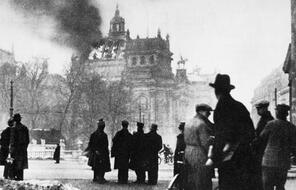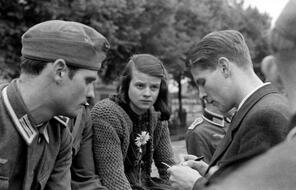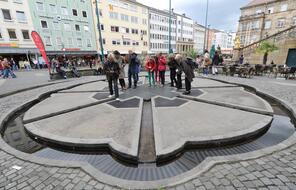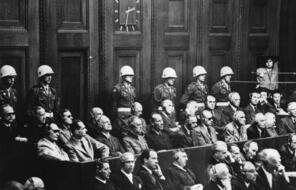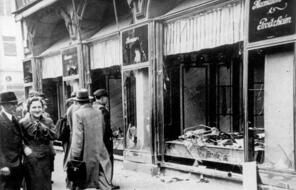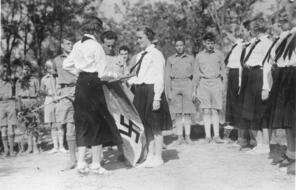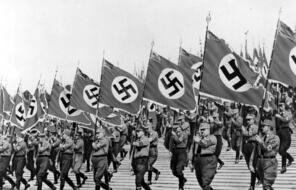Targeting Jews
From the start, Adolf Hitler and his fellow Nazis were determined to resolve the so-called “Jewish question.” In Hitler’s words, Nazi leaders were to bring it up “again and again and again, unceasingly. Every emotional aversion, however slight, must be exploited ruthlessly.” Julius Streicher, the publisher of an antisemitic newspaper known as Der Stürmer (the word means “attacker”), led the way in creating that kind of propaganda, claiming:
The same Jew who plunged the German people into the bloodletting of the World War, and who committed on it the crime of the November Revolution [Weimar Republic] is now engaged in stabbing Germany, recovering from its shame and misery, in the back. . . . The Jew is again engaged in poisoning public opinion. 1
Propaganda was not the only weapon the Nazis used against the Jews. They also relied on terror. On March 9, 1933, just a few days after the elections, Nazi SA storm troopers in Berlin imprisoned dozens of Jewish immigrants from eastern Europe. In Breslau, they attacked Jewish lawyers and judges. On March 13 in Mannheim, they forced Jewish shopkeepers to close their doors. In other towns, they broke into Jewish homes and beat up the people living there.
Although these events were rarely reported in the German press, the foreign press wrote about them regularly. In the United States, many Jews and non-Jews were outraged by the violence. Some called for a boycott of German goods. Their outburst gave the Nazis an excuse for a “defensive action against the Jewish world criminal” on April 1, 1933.
That action—a boycott of Jewish-owned businesses—was the first major public event that specifically targeted Jews not as Communists or Social Democrats but as Jews. It was not a huge success. In some places, Germans showed their disapproval of the boycott by making a point of shopping at Jewish-owned stores on April 1.
Even in places where the boycott took place as planned, the Nazis quickly discovered that it was not always easy to decide if a business was Jewish-owned. There was no legal definition of who was a Jew and who was not. Also, many Jews had non-Jewish business partners, and nearly all had non-Jewish employees. Were those businesses to be closed as well? For example, Tietz, a chain of department stores in Berlin owned by Jews, had more than 14,000 employees, almost all of whom were non-Jews. At a time when unemployment was high and the economy fragile, did the Nazis really want to put those workers out of a job? In the end, the Nazis allowed Tietz to remain open—at least for the time being. A few years later, the owners were forced to turn over their stores to “Aryan” businessmen.
The boycott did succeed, however, in one of its goals: it terrorized Jews throughout Germany. Edwin Landau described what it was like in his hometown in West Prussia. On the Friday before the boycott, he recalled, “one saw the SA [storm troopers] marching through the city with its banners: ‘The Jews are our misfortune.’ ‘Against the Jewish atrocity propaganda abroad.’” He wrote about the day of the boycott:
In the morning hours the Nazi guards began to place themselves in front of the Jewish shops and factories, and every shopper was warned not to buy from the Jews. In front of our business, also, two young Nazis posted themselves and prevented customers from entering. To me the whole thing seemed inconceivable. It would not sink in that something like that could even be possible in the twentieth century, for such things had happened, at most, in the Middle Ages. And yet it was the bitter truth that outside, in front of the door, there stood two boys in brown shirts, Hitler’s executives.
And for this nation we young Jews had once stood in the trenches in cold and rain, and spilled our blood to protect the land from the enemy. Was there no comrade any more from those days who was sickened by these goings-on? One saw them pass by on the street, among them quite a few for whom one had done a good turn. They had a smile on their face that betrayed their malicious pleasure. . . .
I took my war decorations, put them on, went into the street, and visited Jewish shops, where at first I was also stopped. But I was seething inside, and most of all I would have liked to shout my hatred into the faces of the barbarians. Hatred, hatred—when had it become a part of me? — It was only a few hours ago that a change had occurred within me. This land and this people that until now I had loved and treasured had suddenly become my enemy. So I was not a German anymore, or I was no longer supposed to be one. That, of course, cannot be settled in a few hours. But one thing I felt immediately: I was ashamed that I had once belonged to this people. I was ashamed about the trust that I had given to so many who now revealed themselves as my enemies. Suddenly the street, too, seemed alien to me; indeed, the whole town had become alien to me. Words do not exist to describe the feelings that I experienced in those hours. Having arrived at home, I approached the one guard whom I knew and who also knew me, and I said to him: “When you were still in your diapers I was already fighting out there for this country.” He answered: “You should not reproach me for my youth, sir . . . I’ve been ordered to stand here.” I looked at his young face and thought, he’s right. Poor, misguided young people! 2
- 1Quoted in Nora Levin, The Holocaust: The Destruction of European Jewry 1933–1945 (New York: Schocken, 1973), 46.
- 2Edwin Landau, “My Life before and after Hitler,” in Jewish Life in Germany: Memoirs from Three Centuries, ed. Monika Richarz, trans. Stella P. Rosenfeld and Sidney Rosenfeld (Bloomington, IN: Indiana University Press, 1991), 310–12.
Boycott of Jewish Businesses
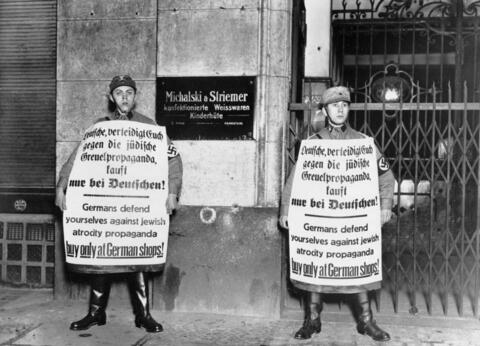
Boycott of Jewish Businesses
SA members in 1933 stand in front of a barricaded Jewish shop, holding signs in both German and English that urge the boycott of Jewish businesses.
Connection Questions
- What was the Nazis’ goal in calling for the boycott? Did it succeed? Why or why not?
- Make a list of choices you think ordinary Germans could have made in response to the boycott. What might have been the consequences of ignoring the boycott? What might have influenced people to go along with the boycott?
- What do you think the Nazis learned from the boycott about the attitudes of the German public toward Jews? What do you think they learned about the willingness of the public to obey Nazi policies?
- When might a boycott be used to express disapproval or to resist a particular policy or practice? In what ways was the boycott of Jewish businesses in Germany different?
- How did the boycott affect the way Edwin Landau thought about his identity?
Get the Handout
How to Cite This Reading
Facing History & Ourselves, “Targeting Jews”, last updated August 2, 2016.


